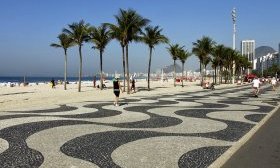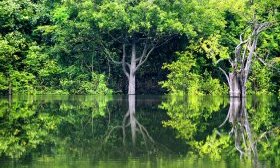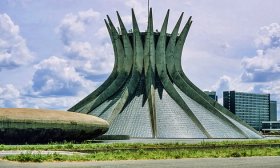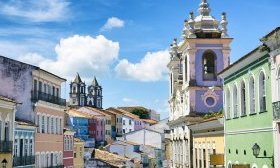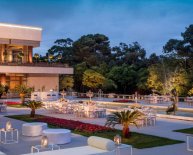
Brazil Tourist places
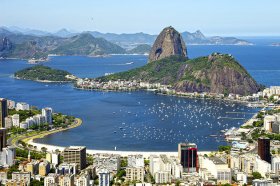
1 Sugar Loaf, Rio de Janeiro
Sugar Loaf, Rio de Janeiro
The easily recognized emblem of Rio de Janeiro, the rounded rock peak of Sugar Loaf juts out of a tree-covered promontory, rising 394 meters above the beaches and city. Its summit is one of the first places tourists go, for views of Rio and the harbor, and for the thrill of riding suspended in a cable car between Sugar Loaf and the Morro da Urca, a lower peak from which a second cableway connects to the city. Rio's first settlement began below these peaks, near the long Praia da Urca beach, and you can tour one of the three early forts there, the star-shaped Fort São João.
2 Cristo Redentor, Rio de Janeiro
Cristo Redentor, Rio de Janeiro
With arms outstretched 28 meters, as if to encompass all of humanity, the colossal Art Deco statue of Christ, called Cristo Redentor (Christ the Redeemer), gazes out over Rio de Janeiro and the bay from the summit of Corcovado. The 709-meter height on which it stands is part of the Tijuca National Park, and a rack railway climbs 3.5 kilometers to its top, where a broad plaza surrounds the statue.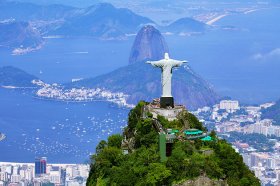 Completed in 1931, the 30-meter statue was the work of Polish-French sculptor Paul Landowski and Brazilian engineer Heitor da Silva Costa, and is constructed of reinforced concrete and soapstone. The eight-meter base encloses a chapel that is popular for weddings. Although this is one of Brazil's most readily recognized icons, it is often mistakenly called The Christ of the Andes, confused with the older statue marking the boundary between Argentina and Chile.
Completed in 1931, the 30-meter statue was the work of Polish-French sculptor Paul Landowski and Brazilian engineer Heitor da Silva Costa, and is constructed of reinforced concrete and soapstone. The eight-meter base encloses a chapel that is popular for weddings. Although this is one of Brazil's most readily recognized icons, it is often mistakenly called The Christ of the Andes, confused with the older statue marking the boundary between Argentina and Chile.
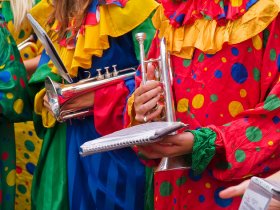 A mid-point stop on the railway leads to trails through the Tijuca National Park, a huge forest that protects springs, waterfalls, and a wide variety of tropical birds, butterflies, and plants. Several more viewpoints open out within the park.
A mid-point stop on the railway leads to trails through the Tijuca National Park, a huge forest that protects springs, waterfalls, and a wide variety of tropical birds, butterflies, and plants. Several more viewpoints open out within the park.
3 Carnaval, Rio de Janeiro
Few shows match Rio's pre-Lenten Carnaval (Carnival) extravaganza for color, sound, action, and exuberance. Make no mistake, this is not just another rowdy street party, but a carefully staged showpiece, where spectators can watch the parades of competing samba dancers from a purpose-built stadium designed by none other than Brazil's best-known architect, Oscar Niemeyer. Called the Sambódromo, this long series of grandstand boxes provides ringside seats to a 700-meter parade route where dancers and musicians from the competing samba schools strut their stuff in a dazzling explosion of brilliant costumes. If mob scenes are less appealing to you than more spontaneous celebrations (that are equally riotous and colorful), you'll also find Carnivals in Salvador, Bahia, Recife, and other Brazilian cities.
4 Iguaçu Falls
 At the point where Brazil, Paraguay, and Argentina meet, the Iguaçu river drops spectacularly in a semicircle of 247 waterfalls that thunder down into the gorge below. Just above the falls, the river is constricted to one-fourth of its usual width, making the force of the water even stronger. Some of the falls are more than 100 meters high and they cover such a broad area that you'll never see all of them at once, but you do get the broadest panorama from the Brazilian side. Catwalks and a tower give you different perspectives, and one bridge reaches all the way to one of the largest, known as the Garganta do Diabo (Devil's Throat). You can cross to the Argentinian side for closer views from catwalks that extend farther into the center of the falls. The two sides offer different perspectives and views, so most tourists plan to see both. The falls are protected by the UNESCO-acclaimed Iguaçu National Park, where subtropical rain forests are the home to more than 1, 000 species of birds and mammals, including deer, otters, ocelots, and capybaras.
At the point where Brazil, Paraguay, and Argentina meet, the Iguaçu river drops spectacularly in a semicircle of 247 waterfalls that thunder down into the gorge below. Just above the falls, the river is constricted to one-fourth of its usual width, making the force of the water even stronger. Some of the falls are more than 100 meters high and they cover such a broad area that you'll never see all of them at once, but you do get the broadest panorama from the Brazilian side. Catwalks and a tower give you different perspectives, and one bridge reaches all the way to one of the largest, known as the Garganta do Diabo (Devil's Throat). You can cross to the Argentinian side for closer views from catwalks that extend farther into the center of the falls. The two sides offer different perspectives and views, so most tourists plan to see both. The falls are protected by the UNESCO-acclaimed Iguaçu National Park, where subtropical rain forests are the home to more than 1, 000 species of birds and mammals, including deer, otters, ocelots, and capybaras.
5 Copacabana, Rio de Janeiro
Copacabana, Rio de Janeiro
Downtown Rio's most fashionable and famous section follows Avenida Nossa Senhora de Copacabana and is bordered all along one side by four kilometers of white sand and breaking surf. The beach is separated from the buildings and traffic by a broad promenade paved in black and white mosaic in an undulating pattern reminiscent of streets in Lisbon, Portugal. The beach isn't just for show. It's also a popular playground filled with sun-worshipers, swimmers, and kids building sand castles whenever the weather is fine. Stroll the streets here to find restaurants, smart shops, cafés, and beautiful old buildings from the days when Rio was Brazil's capital. One of these, the famed Copacabana Palace, is protected as a national monument. Inside its lobby, you can easily imagine seeing the royalty and film idols who have stayed here.
